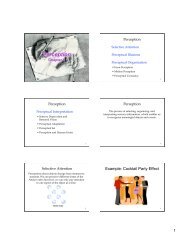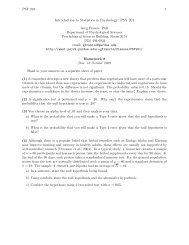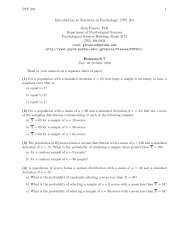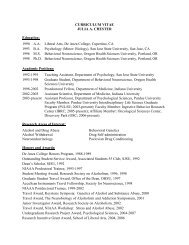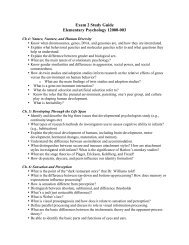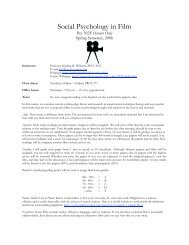Maxims or Myths of Beauty? A Meta-Analytic and Theoretical Review
Maxims or Myths of Beauty? A Meta-Analytic and Theoretical Review
Maxims or Myths of Beauty? A Meta-Analytic and Theoretical Review
Create successful ePaper yourself
Turn your PDF publications into a flip-book with our unique Google optimized e-Paper software.
394 LANGLOIS ET AL.<br />
behavi<strong>or</strong>s <strong>and</strong> traits. 3 Rather, the the<strong>or</strong>y predicts that initially<br />
unrelated traits coevolve because <strong>of</strong> ass<strong>or</strong>tative mating (Buss,<br />
1985; G. F. Miller, 1998). Thus, attractive women tend to choose<br />
intelligent males because such mates have the ability to acquire<br />
resources. Offspring <strong>of</strong> both sexes then tend to inherit both char-<br />
acteristics, attractiveness <strong>and</strong> intelligence. Theref<strong>or</strong>e, both attrac-<br />
tive male <strong>and</strong> female <strong>of</strong>fspring might be expected to be m<strong>or</strong>e<br />
intelligent than unattractive male <strong>and</strong> female <strong>of</strong>fspring. Such a<br />
view would be supp<strong>or</strong>ted if we find no gender differences as a<br />
function <strong>of</strong> attractiveness in our behavi<strong>or</strong>/traits analyses.<br />
Finally, unlike socialization the<strong>or</strong>y, mate selection the<strong>or</strong>y makes<br />
no predictions regarding the imp<strong>or</strong>tance <strong>of</strong> attractiveness f<strong>or</strong> chil-<br />
dren. Because young children are not involved in selecting a mate,<br />
this mechanism is not designed to explain children's behavi<strong>or</strong>.<br />
Good Genes<br />
Good-genes the<strong>or</strong>y predicts that attractiveness should be mean-<br />
ingful in human interactions because attractiveness accurately ad-<br />
vertises health, quality, <strong>and</strong> heterozygosity (Barber, 1995; Gang-<br />
estad & Buss, 1993; Gangestad & Th<strong>or</strong>nhill, 1997; Shackelf<strong>or</strong>d &<br />
Larsen, 1999; Th<strong>or</strong>nhill, 1998; Th<strong>or</strong>nhill & Gangestad, 1993; but<br />
see Kalick et al., 1998, f<strong>or</strong> an alternative). Thus, good-genes the<strong>or</strong>y<br />
should predict differential judgment <strong>and</strong> treatment as a function <strong>of</strong><br />
attractiveness because perceivers have evolved to prefer attractive<br />
people f<strong>or</strong> their good health. The the<strong>or</strong>y also should predict be-<br />
havi<strong>or</strong>al differences in targets as a function <strong>of</strong> attractiveness be-<br />
cause attractiveness signals health, fitness, <strong>and</strong> quality. In contrast,<br />
the the<strong>or</strong>y should predict no differences in behavi<strong>or</strong>s unrelated to<br />
status <strong>and</strong> fitness (e.g., attitudes). Differential judgment <strong>and</strong> treat-<br />
ment should be responses to (rather than causes <strong>of</strong>, as per social<br />
the<strong>or</strong>y) these preexisting differential behavi<strong>or</strong>s <strong>and</strong> traits <strong>of</strong> attrac-<br />
tive <strong>and</strong> unattractive individuals.<br />
In addition, because good health is critical to survival, attrac-<br />
tiveness should be equally relevant <strong>and</strong> imp<strong>or</strong>tant to both sexes<br />
(Thiessen, 1996; Th<strong>or</strong>nhill & Gangestad, 1993), a prediction that<br />
explicitly disagrees with socialization <strong>and</strong> social expectancy the-<br />
odes, as well as with mate-selection the<strong>or</strong>y. Similarly, because<br />
good health is imp<strong>or</strong>tant f<strong>or</strong> all ages, attractiveness should be as<br />
imp<strong>or</strong>tant f<strong>or</strong> children as f<strong>or</strong> adults. This prediction again contrasts<br />
sharply with socialization <strong>and</strong> social expectancy the<strong>or</strong>ies, which<br />
regard behavi<strong>or</strong>al differences as the result <strong>of</strong> cumulative social-<br />
ization. We evaluate these competing predictions in our behavi<strong>or</strong>/<br />
trait analyses.<br />
Differential Parental Solicitude<br />
Differential parental solicitude the<strong>or</strong>y (a derivative <strong>of</strong> Trivers's<br />
[1972] parental investment the<strong>or</strong>y) conjectures that, to enhance<br />
their own reproductive success, parents invest differently in chil-<br />
dren depending on each child's fitness, quality, <strong>and</strong> reproductive<br />
potential (Buss, 1999; Daly, 1990; Daly & Wilson, 1988, 1995).<br />
Parents <strong>and</strong> other adults should allocate m<strong>or</strong>e energy, resources,<br />
attention, <strong>and</strong> care to higher quality <strong>of</strong>fspring (Mann, 1992; Scrim-<br />
shaw, 1984). Thus, if attractiveness is an indicat<strong>or</strong> <strong>of</strong> quality,<br />
adults should invest m<strong>or</strong>e in attractive than unattractive children<br />
<strong>and</strong>, presumably, treat attractive children m<strong>or</strong>e fav<strong>or</strong>ably than<br />
unattractive children (Barden, F<strong>or</strong>d, Jensen, Rogers-Salyer, &<br />
Salyer, 1989; Buss, 1999; Field & Vega-Lahr, 1984; Langlois et<br />
al., 1995).<br />
Second, as with good-genes the<strong>or</strong>y, differential parental solici-<br />
tude the<strong>or</strong>y assumes that differences in health <strong>and</strong> quality should<br />
be manifested by differences in behavi<strong>or</strong> exhibited by attractive<br />
<strong>and</strong> unattractive children <strong>and</strong> adults. Thus, attractive individuals<br />
should possess m<strong>or</strong>e positive behavi<strong>or</strong>s <strong>and</strong> traits than do unat-<br />
tractive individuals.<br />
Third, because the the<strong>or</strong>y is focused on adults' treatment <strong>of</strong><br />
children, it places m<strong>or</strong>e imp<strong>or</strong>tance than the other fitness-related<br />
evolutionary the<strong>or</strong>ies on differential treatment <strong>of</strong> children. By this<br />
logic, attractiveness is perhaps even m<strong>or</strong>e imp<strong>or</strong>tant f<strong>or</strong> children<br />
than f<strong>or</strong> adults, but the the<strong>or</strong>y does not make any explicit predic-<br />
tions about age differences in the imp<strong>or</strong>tance <strong>of</strong> attractiveness.<br />
Finally, because the the<strong>or</strong>y assumes that attractiveness is an<br />
equally valid indicat<strong>or</strong> <strong>of</strong> health <strong>and</strong> quality in boys <strong>and</strong> girls, no<br />
gender differences would be expected in how boys <strong>and</strong> girls are<br />
judged <strong>and</strong> treated as a function <strong>of</strong> attractiveness (Daly & Wilson,<br />
1995).<br />
Purpose<br />
This article has three primary goals. The first goal is to extend<br />
knowledge <strong>of</strong> attractiveness effects beyond stranger-attribution<br />
paradigms to determine the extent to which attractiveness influ-<br />
ences daily lives <strong>and</strong> real interactions. The second goal is to<br />
examine the contradiction between common knowledge, as exem-<br />
plified by the three maxims, <strong>and</strong> empirical fmdings about facial<br />
attractiveness. The third goal is to use extant research to evaluate<br />
the current status <strong>of</strong> socialization/social expectancy the<strong>or</strong>y <strong>and</strong><br />
fitness-related evolutionary the<strong>or</strong>y as the<strong>or</strong>etical accounts <strong>of</strong> at-<br />
tractiveness effects. Although no single the<strong>or</strong>y is likely to be<br />
unif<strong>or</strong>mly supp<strong>or</strong>ted <strong>or</strong> disconfumed, our hope is that the review<br />
will highlight areas <strong>of</strong> strongest supp<strong>or</strong>t <strong>and</strong>, m<strong>or</strong>e imp<strong>or</strong>tantly,<br />
will show where future research is needed to comprehensively<br />
evaluate the different the<strong>or</strong>etical perspectives.<br />
To accomplish these goals, we conducted a variety <strong>of</strong> meta-<br />
analyses. Four meta-analyses <strong>of</strong> attractiveness reliability coeffi-<br />
cients evaluated interrater agreement about attractiveness, both<br />
within <strong>and</strong> across cultures. Two met/l-analyses summarized re-<br />
search investigating global but inf<strong>or</strong>med evaluations <strong>of</strong> attractive<br />
<strong>and</strong> unattractive people, <strong>and</strong> two meta-analyses summarized stud-<br />
ies <strong>of</strong> differential treatment <strong>of</strong> attractive <strong>and</strong> unattractive people.<br />
Three meta-analyses evaluated assessments <strong>of</strong> behavi<strong>or</strong> <strong>and</strong> per-<br />
sonal characteristics as a function <strong>of</strong> attractiveness.<br />
Finally, our analyses assessed whether the effects <strong>of</strong> attractive-<br />
ness apply to some groups m<strong>or</strong>e than to others. Because <strong>of</strong> the<br />
gender <strong>and</strong> age predictions made by the different the<strong>or</strong>ies, we<br />
evaluated the moderating influences <strong>of</strong> gender <strong>and</strong> age on the<br />
3 Although the the<strong>or</strong>y at first glance seems to predict that attractiveness<br />
should be m<strong>or</strong>e imp<strong>or</strong>tant in the dating <strong>and</strong> sexual experiences <strong>of</strong> women<br />
than in those <strong>of</strong> men, it is not possible to make such a straightf<strong>or</strong>ward<br />
prediction. First, most men may not be able to successfully date very<br />
attractive women <strong>and</strong> thus may not ask them out (Buss & Schmitt, 1993).<br />
Furtherm<strong>or</strong>e, men may have less stringent st<strong>and</strong>ards f<strong>or</strong> attractiveness<br />
when seeking a sh<strong>or</strong>t-term mate than when seeking a long-term mate (Buss,<br />
1999; Buss & Schmitt, 1993), <strong>and</strong> the particular strategy used by men in<br />
most <strong>of</strong> the retrieved studies cannot be determined.





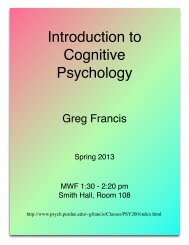

![Exam 4 Study Guide[1]](https://img.yumpu.com/45196739/1/190x245/exam-4-study-guide1.jpg?quality=85)
